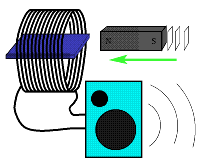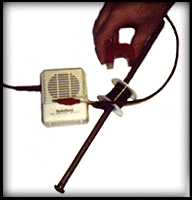Barkhausen Experiment

Richard Feynman, one of the most famous physicists since Einstein,
tells us how to set up an experiment to hear the crackling noise in magnets
in his ``Lectures on Physics'' (section II.37-3).
``It is not hard to show that the magnetization process ... is jerky -
that the domain walls jerk and snap as they shift. All you need is a
coil of wire - with many thousands of turns - connected to an amplifier
and a loudspeaker ... If you put a few silicon steel sheets (of the type
used in transformers) at the center of the coil and bring a bar magnet
slowly near the stack, the sudden changes in magnetization will produce
impulses of emf in the coil, which are heard as distinct clicks in the
loudspeaker. As you move the magnet nearer to the iron you will hear a
whole rush of clicks that sound something like the noise of sand grains
falling over each other as a can of sand is tilted. The domain walls are
jumping, snapping, and jiggling as the field is increased. This
phenomenon is called the Barkhausen effect.''
Now, these lectures were for freshman in college at Caltech, so Dr. Feynman
talks about silicon steel and something called EMF. Magnets don't
make sound in your ears when they crackle, but they do produce currents in
nearby wires through something called the electromotive force, which
Feynman calls EMF. By hooking the wires up to a loudspeaker, you can hear
the magnet crackle!
 Try it! You can get
some magnet wire and a small amplified speaker at your local Radio
Shack, and you can get a magnet and a large iron nail at the Hardware
store. Connect the coil of wire to the speaker, put the nail inside
the coil, and move the magnet closer and farther to the nail. What do
you hear? A picture of our own set-up is on the right.


|


